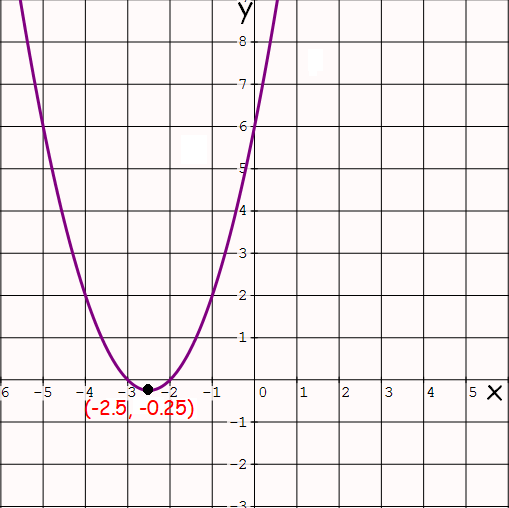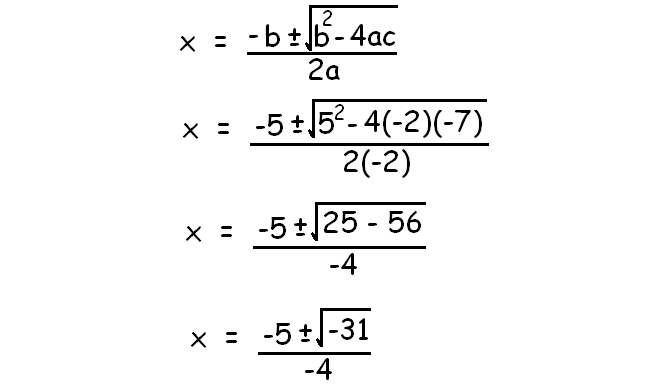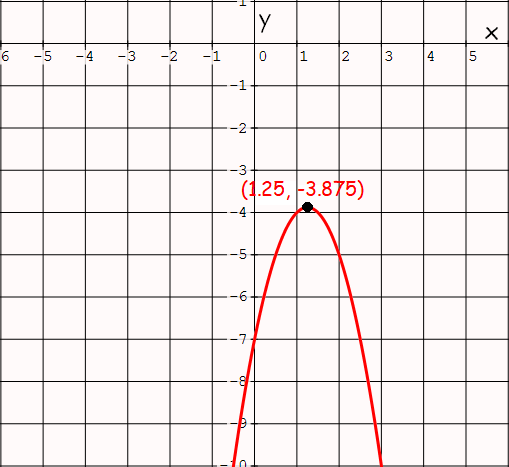EXPLORING GRAPHS OF QUADRATIC FUNCTIONS
Subscribe to our ▶️ YouTube channel 🔴 for the latest videos, updates, and tips.
The graph of any quadratic function will be a parabola.
The general form of a quadratic function is
y = ax2 + bx + c
To explore the graphs of quadratic functions, we have to be aware of the following stuff.
(i) Open upward or open downward parabola
(ii) Vertex
(iii) x - intercepts
(x - intercepts are nothing but the points where the curve cuts x - axis)
(iv) y - intercept
(y - intercepts are nothing but the points where the curve cuts y - axis)
Let us see the above stuff in detail.
(i) Open upward or downward :
y = ax2 + bx + c
If the leading coefficient or the sign of 'a' is positive, the parabola is open upward and 'a' is negative, the parabola is open downward.
(ii) Vertex :
To find the vertex of the parabola which is given by the quadratic function y = ax2 + bx + c, we have to find the value x using the formula given below.
x = -b / 2a
And the vertex is
[-b/2a, y(-b/2a)]
(iii) X - intercepts :
To know the x - intercepts, we have to plug y = 0 in
y = ax2 + bx + c
and find the values of x.
Note :
If the values of x are imaginary, the curve will not intersect x - axis.
(iii) Y - intercept :
To know the y - intercept, we have to plug x = 0 in
y = ax2 + bx + c
and find the value of y.
Based on the results which we get from the above four points, we have to sketch parabola.
Example 1 :
Graph the quadratic equation that is given below.
x2 + 5x + 6 = 0
Solution :
Let y = x2 + 5x + 6
Step 1 :
In the given quadratic function, since the leading coefficient (x2) is positive, the parabola will be open upward.
Step 2 :
When the given quadratic function is compared to
y = ax2 + bx + c,
we get
a = 1
b = 5
c = 6
x coordinate of the vertex is
= -b / 2a
= -5 / 2(1)
= -5 / 2
= -2.5
y coordinate of the vertex is
= y(-2.5)
= (-2.5)2 + 5(-2.5) + 6
= 6.25 - 12.5 + 6
= -0.25
So, the vertex is (-2.5, -0.25).
Step 3 :
To know x - intercept, we have to substitute y = 0 in the given quadratic function.
Then, we have
0 = x2 + 5x + 6 or x2 + 5x + 6 = 0
(x + 2)(x + 3) = 0
x + 2 = 0 or x + 3 = 0
x = -2 or x = -3
Therefore, the parabola cuts x - axis at
x = -2 and x = -3
Step 4 :
To know y - intercept, we have to substitute x = 0 in the given quadratic function.
Then, we have
y = (0)2 + 5(0) + 6
y = 6
Therefore, the parabola cuts y - axis at y = 6.
Now, let us sketch the parabola.

Example 2 :
Graph the quadratic equation that is given below.
-2x2 + 5x - 7 = 0
Solution :
Let y = -2x2 + 5x - 7
Step 1 :
In the given quadratic function, since the leading coefficient (x2) is negative, the parabola will be open downward.
Step 2 :
When the given quadratic function is compared to
y = ax2 + bx + c,
we get
a = -2
b = 5
c = -7
x coordinate of the vertex is
= -b / 2a
= -5 / 2(-2)
= -5 / (-4)
= 1.25
y coordinate of the vertex is
= y(1.25)
= -2(1.25)2 + 5(1.25) - 7
= -3.125 + 6.25 - 7
= -3.875
So, the vertex is (1.25, -3.875).
Step 3 :
To know x - intercept, we have to plug y = 0 in the given quadratic function.
Then, we have
0 = -2x2 + 5x -7 or -2x2 + 5x - 7 = 0
The above quadratic equation can not be solved using factoring.
So let us try to solve the equation using quadratic formula as given below

Clearly, the two values of x are imaginary.
Therefore, the parabola does not cut x - axis.
Step 4 :
To know y - intercept, we have to substitute x = 0 in the given quadratic function.
Then, we have
y = -2(0)2 + 5(0) - 7
y = -7
Therefore, the parabola cuts y - axis at y = -7.
Now, let us sketch the parabola.

Subscribe to our ▶️ YouTube channel 🔴 for the latest videos, updates, and tips.
Kindly mail your feedback to v4formath@gmail.com
We always appreciate your feedback.
©All rights reserved. onlinemath4all.com
Recent Articles
-
10 Hard SAT Math Questions (Part - 38)
Dec 08, 25 12:12 AM
10 Hard SAT Math Questions (Part - 38) -
SAT Math Practice
Dec 05, 25 04:04 AM
SAT Math Practice - Different Topics - Concept - Formulas - Example problems with step by step explanation -
10 Hard SAT Math Questions (Part - 37)
Dec 03, 25 07:02 AM
10 Hard SAT Math Questions (Part - 37)


